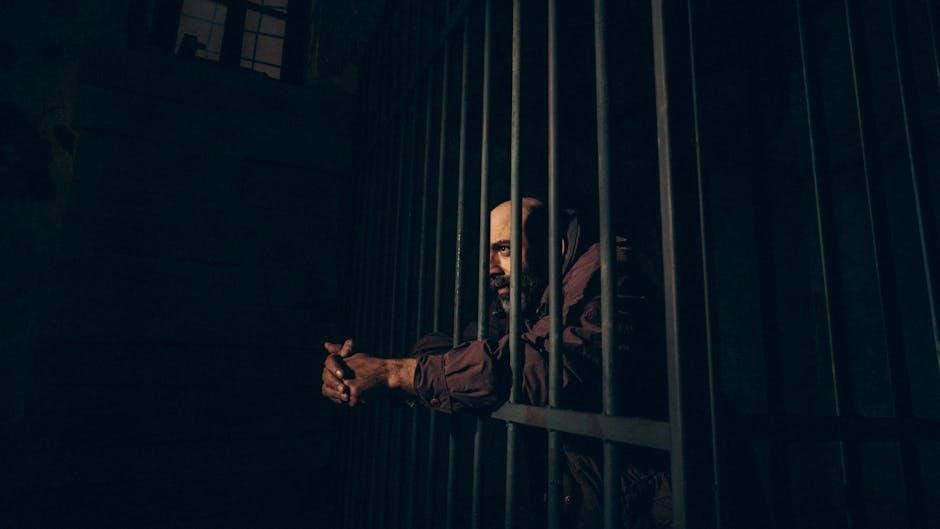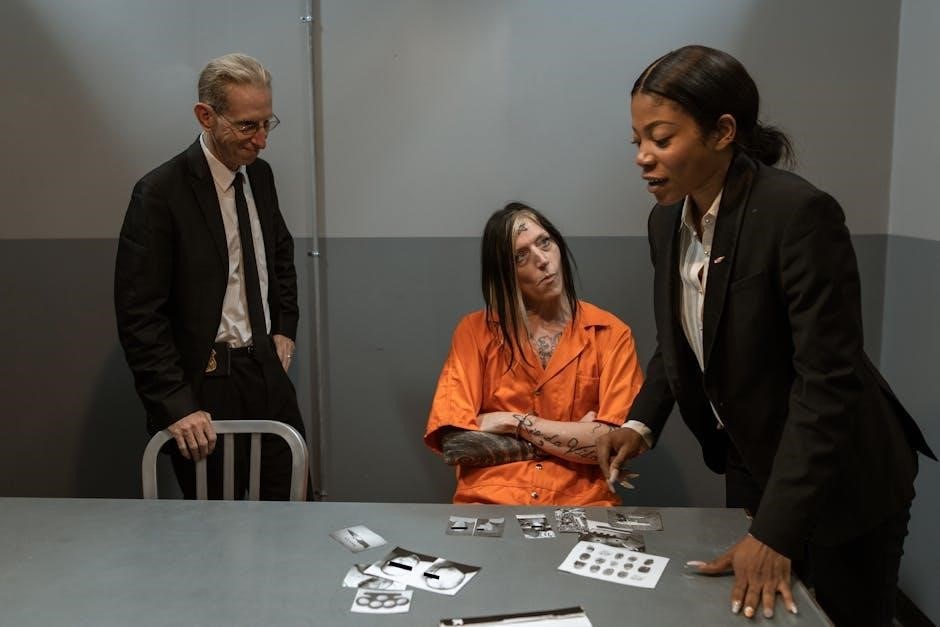
the prisoner of azkaban pdf
Harry Potter and the Prisoner of Azkaban, published in 1999, is the third book in J․K․ Rowling’s series․ It introduces Sirius Black, a mysterious figure believed to threaten Harry, while exploring themes of friendship and redemption․ The story unfolds during Harry’s third year at Hogwarts, where dark secrets and magical creatures shape his destiny․ The book is widely acclaimed for its emotional depth and intricate plot, making it a cornerstone of the Harry Potter saga․

1․1 Overview of the Book and Film
Harry Potter and the Prisoner of Azkaban, published in 1999, marks the third installment in J․K․ Rowling’s beloved series․ The book follows Harry’s third year at Hogwarts, where the mysterious Sirius Black escapes from Azkaban Prison, believed to be coming for Harry․ The 2004 film adaptation, directed by Alfonso Cuarón, captures the dark, eerie atmosphere introduced by the Dementors and the Patronus Charm․ Both the book and film explore themes of friendship, redemption, and the truth about Harry’s past, deepening his connection to Sirius and the wizarding world․ The story is praised for its emotional depth and intricate plot, making it a fan favorite․
1․2 Historical Context and Publication Details
Harry Potter and the Prisoner of Azkaban was published in the United Kingdom on July 8, 1999, and in the United States on September 8, 1999․ J․K․ Rowling began writing the book immediately after completing the second installment, Harry Potter and the Chamber of Secrets․ The novel marked a turning point in the series, introducing darker themes and complex characters․ It received widespread critical acclaim and won the Whitbread Children’s Book Award in 1999․ The book’s success solidified the Harry Potter series as a cultural phenomenon, with its third film adaptation, directed by Alfonso Cuarón, released in 2004 to further acclaim․

Key Characters in “The Prisoner of Azkaban”
Sirius Black, a mysterious escaped prisoner, is central to the story․ Harry Potter, alongside Ron Weasley and Hermione Granger, navigates danger and uncover truths․ The Dementors add an eerie presence, influencing the plot’s dark tone․
2․1 Sirius Black: The Mysterious Prisoner
Sirius Black is a central figure in the story, believed to have betrayed Harry’s parents to Voldemort, leading to their deaths․ Escaping from Azkaban, he is presumed to be coming for Harry․ However, his true identity and motives are shrouded in mystery․ Throughout the book, Harry uncovers the truth about Sirius, revealing a loyal friend and innocent man wrongly accused․ Sirius’s connection to Harry’s parents and his relationship with Harry add depth to the narrative, highlighting themes of betrayal, redemption, and the complexity of adult relationships․
2․2 Harry Potter and His Friends
Harry, Ron, and Hermione return for their third year at Hogwarts, facing new challenges and dangers․ The trio’s bond is tested as they navigate the mystery of Sirius Black, whose escape from Azkaban casts a dark shadow over the school․ Harry’s vulnerability is heightened by the presence of Dementors, foul creatures that feed on human happiness․ Ron and Hermione remain loyal, supporting Harry through his fears and uncertainties․ Together, they uncover hidden truths and confront the darkness surrounding Sirius Black, showcasing the strength of their friendship and their growing maturity in the face of adversity․
2․3 The Role of Dementors
Dementors are foul creatures that serve as the guards of Azkaban prison, feeding on human happiness and leaving their victims in a state of despair․ Their presence at Hogwarts spreads fear and gloom, as they search for Sirius Black․ These dark beings are drawn to negative emotions, making Harry, with his traumatic past, particularly vulnerable․ The Dementors’ ability to suck the soul of their victims adds to the story’s tension․ Harry learns to combat them using the Patronus Charm, a powerful spell that requires concentration and a happy memory, highlighting his growing magical prowess and resilience․

Major Themes and Plot Points
The story explores themes of friendship, betrayal, and redemption, as Harry uncovers the truth about Sirius Black and confronts the dark forces threatening his world․ It delves into the battle against depression and the power of hope and loyalty, while revealing the complexities of the wizarding world and its history․ The plot masterfully intertwines mystery, adventure, and emotional depth, making it a pivotal chapter in Harry’s journey․
3․1 The Escape from Azkaban
The escape of Sirius Black from Azkaban Prison sets the stage for the story’s tension and mystery․ Black, believed to have betrayed Harry’s parents to Voldemort, is thought to be coming for Harry․ The breakout, unheard of in Azkaban’s history, shocks the wizarding world․ Dementors, the prison’s terrifying guards, are dispatched to recapture Black, heightening the sense of danger․ Harry learns of Black’s connection to his parents and must navigate the truth about his past, while the escape itself remains a central enigma driving the plot forward with suspense and intrigue․
3․2 The Truth About Sirius Black
The truth about Sirius Black reveals his innocence and deep connection to Harry’s parents․ Believed to have betrayed them to Voldemort, Black is later proven to be Harry’s godfather and a loyal friend to the Potters․ His wrongful imprisonment in Azkaban for 12 years is exposed, as well as his escape to clear his name․ With the help of Harry, Ron, and Hermione, Black’s innocence is revealed, uncovering Peter Pettigrew’s betrayal․ This revelation transforms Harry’s understanding of his family’s past and his own identity, adding emotional depth to the story and highlighting themes of loyalty and redemption․
The Marauders—James Potter, Sirius Black, Remus Lupin, and Peter Pettigrew—were a close-knit group of Hogwarts students in the 1970s․ Their friendship and adventures shaped the wizarding world․ They created the Marauder’s Map, a magical chart revealing every person’s location within the castle․ This invention became crucial for Harry, Ron, and Hermione as they navigated their own challenges․ The Marauders’ legacy, marked by loyalty and ingenuity, deeply influenced Harry’s understanding of his father and his connection to Sirius and Remus․ Their story, intertwined with the present, adds layers of history and emotion to the narrative․

Magical Elements and Creatures
The book introduces Dementors, foul creatures that guard Azkaban, feeding on human happiness․ Their presence causes fear, affecting Harry and others․ The Patronus Charm emerges as a protective spell against them, showcasing magical defense mechanisms․ Additionally, the Shrieking Shack holds secrets tied to Lupin’s werewolf transformations, blending mystery with magical lore․ These elements enrich the story’s magical depth and contribute to its enchanting atmosphere, highlighting Rowling’s creativity in crafting a compelling wizarding world․
4․1 The Patronus Charm
The Patronus Charm, introduced in Harry Potter and the Prisoner of Azkaban, is a powerful defensive spell that repels Dementors․ Harry learns this complex magic from Professor Lupin, requiring focus and a happy memory to conjure a silvery Patronus․ The spell’s success depends on the caster’s ability to concentrate, making it challenging for young wizards․ Harry’s Patronus takes the form of a stag, symbolizing his connection to his father․ This charm highlights the emotional and mental strength needed in magical warfare, becoming a pivotal tool against the soul-sucking Dementors that haunt Harry throughout the story․
4․2 The Shrieking Shack and Its Secrets
The Shrieking Shack, an eerie structure near Hogwarts, holds significant secrets in Harry Potter and the Prisoner of Azkaban․ Believed to be haunted, it is revealed as a haven for Remus Lupin during his werewolf transformations․ The Shack’s hidden passage connects to the castle, used by Lupin and his friends, the Marauders․ Here, Harry uncovers the truth about Sirius Black’s innocence and his father’s friendship with Lupin․ The Shack becomes a pivotal location, unraveling mysteries and showcasing loyalty and betrayal, making it a cornerstone of the story’s emotional and magical unraveling․

The Book’s Impact and Reception
Harry Potter and the Prisoner of Azkaban received widespread acclaim for its mature themes and emotional depth, solidifying the series’ cultural impact and loyal fan base․
5․1 Awards and Critical Acclaim
Harry Potter and the Prisoner of Azkaban earned the Whitbread Children’s Book Award in 1999, praising its emotional depth and darker themes․ Critics lauded the novel for its intricate plot and character development, marking a maturation in the series․ Fans and reviewers alike celebrated its ability to balance magic with poignant storytelling, further cementing its place as a beloved installment in the Harry Potter saga․ The book’s success was a testament to Rowling’s mastery of crafting compelling narratives that resonate with readers of all ages․
5․2 The Cultural Significance of the Story
Harry Potter and the Prisoner of Azkaban holds significant cultural importance as it marked a turning point in the series, introducing darker themes and emotional complexity․ The story resonated globally, sparking discussions about mental health, friendship, and redemption․ Its exploration of depression through Dementors and the Marauders’ backstory added depth to the wizarding world․ The book’s success paved the way for the series’ growth into a cultural phenomenon, influencing films, games, and fan culture․ Its impact continues to inspire audiences, solidifying its place in literary and pop culture history;

The Film Adaptation
Directed by Alfonso Cuarón, the 2004 film adaptation of Harry Potter and the Prisoner of Azkaban brought the story to life with a darker tone and emotional depth․ Starring Daniel Radcliffe, Rupert Grint, and Emma Watson, the movie captured the essence of the novel, introducing key characters like Sirius Black and Dementors․ Its critically acclaimed direction and faithful adaptation solidified its place as a standout installment in the franchise․
6․1 Director Alfonso Cuarón’s Vision
Alfonso Cuarón’s direction in Harry Potter and the Prisoner of Azkaban marked a significant shift in tone, bringing a darker, more mature atmosphere to the series․ His visual style emphasized high-contrast lighting and innovative camera angles, creating an eerie yet captivating aesthetic․ Cuarón focused on emotional depth, particularly in exploring Harry’s vulnerability and the complexity of Sirius Black’s character․ His interpretation of the Time-Turner and the Shrieking Shack scenes remains iconic․ Cuarón’s visionary approach not only enhanced the story’s magical elements but also deepened its emotional resonance, making the film a standout in the franchise․
6․2 Key Scenes and Differences from the Book
The film adaptation of Harry Potter and the Prisoner of Azkaban includes iconic scenes like Harry’s first encounter with Dementors and the Time-Turner sequence․ However, some details from the book were omitted or simplified, such as the Marauders’ backstory and the full explanation of the Time-Turner’s mechanics․ The Shrieking Shack scene was intensified for cinematic effect, with a greater emphasis on visual horror․ The film also reduced the role of Ginny Weasley and omitted the subplot involving Bertha Jorkins․ Despite these changes, the movie remained faithful to the book’s core themes and emotional depth, enhancing the story’s magical and atmospheric elements for the screen․